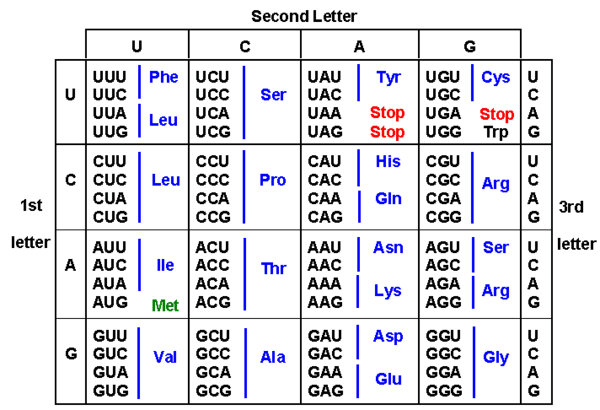CH391L/S12/TranslationRBSandCodons
Translation
Translation is the third stage of protein synthesis and proceeds in four phases: activation, initiation, elongation and termination. Activation occurs when an amino acid is covalently bonded to a tRNA. [1] Initiation follows when the ribosome binds to the 5' end of mRNA. This allows translation to build a particular protein. This process is halted once a stop codon (UAA, UAG, or UGA) is reached because no tRNA can bind to these codons. What does recognize this codon is a "release factor" protein that disassembles the ribosome/mRNA complex.
An illustration of this process is shown as follows:
Shown above is a ribosome translating a protein that is secreted into the endoplasmic reticulum. tRNAs are colored dark blue.
Bacterial Ribosome Binding Sites

A ribosome binding site (RBS) is a region 6-7 nucleotides upstream of the start codon AUG in prokaryotes called the Shine-Dalgarno sequence (5′–GGAGGU–3′). The ribosome will base pair with this site through its own rRNA as well at the start codon using tRNA. What makes this an interesting topic of research is the fact that the Shine-Dalgarno sequence is not the "optimal" RBS for all expression processes. In other words, a RBS affects the rate at which a particular Open Reading Frame (ORF) is translated. There are two general ways in which this happens: i) the rate at which ribosomes are recruited to the mRNA and initiate translation is dependent on the sequence of the RBS and ii) the RBS can also affect the stability of the mRNA, thereby affecting the number of proteins made over the lifetime of the mRNA.
RBS Sequence Design
The first variable to be taken into account should be the sequence of the RBS itself, specifically to what degree the RBS is complementary to the free end of the 16s rRNA. If this hybridization is highly favorable, then the time needed to complete the initiation phase will be reduced allowing elongation to proceed. Obviously the start codon AUG must be upstream of the RBS and needs to lie 6-7 nt. The reason for such a specific distance is due to the geometry of the ribosome and where it attaches itself to the mRNA. Not only is the exact sequence of the RBS important, but the overall sequence of the mRNA will affect translation rates. Secondary structure in mRNA has been shown to affect translation rates [2] due to competitive binding of the RBS by the ribosome as well as other nucleotides in the mRNA. Many attempts have been made to computationally predict the best sequence to minimize secondary structure in DNA/RNA. CircDesigNA is one such tool .
Codon Optimization
Genetic code is defined by a sequence of three nucleotides, called codons. These codons can serve three functions. 1) The start codon, AUG is used to initiate translation 2) Specific

codons stop translation by not coding for anything 3) They serve as a template to allow the binding of amino acids to form a protein. Crick and Brenner et al. were the first to show that codons existed and that they coded for specific amino acids. [3] They translated a poly-uracil (UUUUUUU...) sequence in vitro and discovered that the only amino acid synthesized was phenlyalanine. Using similar methods, all codon combinations (4^3 = 64 total) were assigned to the twenty amino acids. This has led to developments in determining both theoretically and experimentally what codons work best for particular genes that need to be expressed[4]. This attempt at randomly varying the codons used the express GFP and found that there was a 250 fold range in protein levels across the 154 genes that were synthetically produced. However upon further investigation, they determined that secondary structure in the mRNA accounted for more than half of the variations in expression. They did not find that codon bias affected the results as much as anticipated.
Eukaryotes vs. Prokaryotes
The heart of codon optimization lies in the fact that bacteria do not always use the same codon for amino acids that eukaryotic cells do. This has given rise to online tools that help determine the correct sequence needed to express genes in various host organisms. Ribosome Binding Sites and Codon Optimization
References
<biblio>
- Laursen2005 pmid=15755955
//Initiation of protein synthesis in bacteria.
- Gold1990 pmid=2199797
//Overview of high-level translation initiation.
- Crick1961 pmid=13882203
//General nature of the genetic code for proteins.
- Kudla2009 pmid=19359587
//Coding-Sequence Determinants of Gene Expression in Escherichia coli